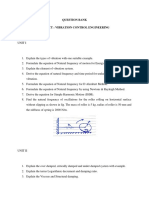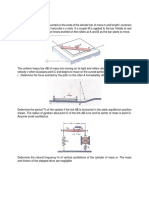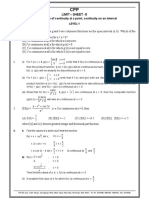Sheet1 اهتزازات
Sheet1 اهتزازات
Uploaded by
احمد الربيعيCopyright:
Available Formats
Sheet1 اهتزازات
Sheet1 اهتزازات
Uploaded by
احمد الربيعيCopyright
Available Formats
Share this document
Did you find this document useful?
Is this content inappropriate?
Copyright:
Available Formats
Sheet1 اهتزازات
Sheet1 اهتزازات
Uploaded by
احمد الربيعيCopyright:
Available Formats
Q1 Represent the vibratory system given in Figure Sh1 as an equivalent vibratory system
with mass me, equivalent stiffness ke, and equivalent damping coefficient ce.
Fig. Sh1, Q1
Q2: A vibratory system has a mass m =10 kg, k =1500 N/m, and c= 2500 N/(m/s). Given
that the displacement response has the form 𝑥(𝑡) = 0.2𝑠𝑖𝑛(9𝑡) m, plot the graphs of 𝑥̈ , the
spring force kx, and the damper force cẋ versus time and discuss them.
Q3: Consider the pulley system shown in Fig. Sh2.Q3 The
mass of each pulley is small compared with the mass m
and, therefore, can be ignored. Furthermore, the cord
holding the mass is inextensible and has negligible mass.
Obtain an expression for the natural frequency of the
system.
Fig. Sh1.Q3
Q4: A 45 kg mass is attached to rod AB and to three
springs as in fig. Sh1.Q4. determine the natural frequency
of small oscillations of the system if the mass of rod AB is
negligible. Under what conditions will stable oscillations
occur?
Fig. Sh1.Q4
𝑚
Q5: As in Fig. Sh1.Q5, a massless bar of length L is
pinned at its center. It carries a mass 𝑚 at its top end and a
mass 3𝑚 at the bottom. At the quarter point is attached a
𝐿
linear spring having a constant K. find the differenatial
𝐾
equation of motion and the natural frequency of small
𝐿/4
oscillations using the energy method.
Fig. Sh1.Q5 3𝑚
Q6: For the fluid-float system shown in Fig. Sh1.Q6 , Jo is the mass moment of inertia about
point O. Assume that the mass of the bar is mo. Answer the following.
a) For “small” angular oscillations, derive the governing equation of motion for the fluid
float system.
b) What is the value of the damping coefficient cc for which the system is critically
damped?
Fig. Sh1.Q6
Q7: The spring attachment point B is given a
horizontal motion XB =b cos ωt. Determine the
driving frequency ω for which the oscillations of
the mass 𝑚 tend to become excessively large.
Neglect the friction and mass associated with the
pulleys. The two springs have the same stiffness k.
You might also like
- E5 Part IA Formal ReportDocument15 pagesE5 Part IA Formal ReportbpmurtaNo ratings yet
- Spring Oscillator Lab ReportDocument10 pagesSpring Oscillator Lab ReportVincent Vuong100% (2)
- Tutorial 1 Topic: Vibration BNJ 20303 Mechanic of Machine SEMESTER 1 SESI 2020/2021Document6 pagesTutorial 1 Topic: Vibration BNJ 20303 Mechanic of Machine SEMESTER 1 SESI 2020/2021Jojnojie DannyzNo ratings yet
- Periodic Motion: Powerpoint Lectures ForDocument44 pagesPeriodic Motion: Powerpoint Lectures ForAnonymous s6Gtfr2100% (3)
- ME34ME505 - Vibration and Noise ControlPractice Problems IDocument20 pagesME34ME505 - Vibration and Noise ControlPractice Problems IMUHAMMAD ASJAD AAMIR AAMIR AMINNo ratings yet
- Tutorials Chapter2 SDOFDocument6 pagesTutorials Chapter2 SDOFUlrich Simo DomguiaNo ratings yet
- Tutorial2 Solved SDOFDocument19 pagesTutorial2 Solved SDOFUlrich Simo DomguiaNo ratings yet
- Numericals of Forced Vib Lec#06Document7 pagesNumericals of Forced Vib Lec#06Qamar Uz ZamanNo ratings yet
- Hooke's Law and Simple Harmonic Motion: ObjectivesDocument9 pagesHooke's Law and Simple Harmonic Motion: ObjectivesDeep PrajapatiNo ratings yet
- APhO 2017 Theory 1Document8 pagesAPhO 2017 Theory 1mpecthNo ratings yet
- Vortices in Super Uid: TheoryDocument20 pagesVortices in Super Uid: Theoryfernando4talaveraNo ratings yet
- Lotte Holmegaard Et Al - Control of Rotational Wave-Packet Dynamics in Asymmetric Top MoleculesDocument4 pagesLotte Holmegaard Et Al - Control of Rotational Wave-Packet Dynamics in Asymmetric Top MoleculesMddl2aNo ratings yet
- Lab 13Document3 pagesLab 13Maruf AhmedNo ratings yet
- Oscillations, Waves and OpticsDocument80 pagesOscillations, Waves and OpticsalayuNo ratings yet
- CH 2 ExercisesDocument11 pagesCH 2 Exercisesanwar691841519No ratings yet
- Question Bank For VceDocument5 pagesQuestion Bank For Vcecpt.ghostNo ratings yet
- Practice Problems For Advanced Vibrations: April 2019Document36 pagesPractice Problems For Advanced Vibrations: April 2019KEVIN CORDOVA RODRIGUEZ100% (1)
- Practice Problems For Advanced Vibrations: April 2019Document36 pagesPractice Problems For Advanced Vibrations: April 2019Animesh ChandraNo ratings yet
- Practice Problems For Advanced Vibrations: April 2019Document36 pagesPractice Problems For Advanced Vibrations: April 2019Animesh ChandraNo ratings yet
- OscillationsDocument37 pagesOscillationsRicky CementNo ratings yet
- Nonlinearity and Periodic Solution of Standard-Beam Balance Oscillation SystemDocument6 pagesNonlinearity and Periodic Solution of Standard-Beam Balance Oscillation Systemtorrantorran6No ratings yet
- Kibble BalanceDocument11 pagesKibble BalanceMai Leeroy NaCarlosNo ratings yet
- Question Bank Subject: Vibration Control EngineeringDocument5 pagesQuestion Bank Subject: Vibration Control EngineeringOmNo ratings yet
- 14-Experiment 11Document3 pages14-Experiment 11ZuhdiismailNo ratings yet
- Soal Untuk Ujian Materi Getaran-ADocument2 pagesSoal Untuk Ujian Materi Getaran-ADella KhoirunnisaNo ratings yet
- Series 02Document2 pagesSeries 02m.kessadNo ratings yet
- The Spiral SpringDocument11 pagesThe Spiral SpringAyogu Ebubechi GloryNo ratings yet
- TALLER 1 Vibraciones LibresDocument11 pagesTALLER 1 Vibraciones LibresAlexis FlexyNo ratings yet
- Vs S Based ControlDocument12 pagesVs S Based ControlHarsha VardhanNo ratings yet
- Tutorial 04 - Damped Undamped Vibration - Final VersionDocument2 pagesTutorial 04 - Damped Undamped Vibration - Final VersionsnafuxxspartanNo ratings yet
- Assignment 2Document2 pagesAssignment 2Nicholas Lorenzo LacheeNo ratings yet
- Rotation of PlateDocument4 pagesRotation of PlateLucas Araujo de AlmeidaNo ratings yet
- TALLER 1 Vibraciones LibresDocument11 pagesTALLER 1 Vibraciones LibresPortugal SergioNo ratings yet
- Assignment 1Document3 pagesAssignment 1shethNo ratings yet
- Dynamics Lab MANUAL New PrintDocument56 pagesDynamics Lab MANUAL New PrintMartin De Boras PragashNo ratings yet
- AssignmentDocument4 pagesAssignmentsadi mohammadNo ratings yet
- Revision: Previous Lecture Was About Applications of Euler-Lagrange Equations Euler-Lagrange Equations (Different Forms)Document24 pagesRevision: Previous Lecture Was About Applications of Euler-Lagrange Equations Euler-Lagrange Equations (Different Forms)ediealiNo ratings yet
- Propuestas E2 MsDocument3 pagesPropuestas E2 MsPedro OlivoNo ratings yet
- X X X A T: MECH 364 Assignment 2Document9 pagesX X X A T: MECH 364 Assignment 2Chandra SekarNo ratings yet
- Assignment-1 Vibrations 2017Document3 pagesAssignment-1 Vibrations 2017Arpit Sharma0% (1)
- Birla Institute of Technology and Science, Pilani Hyderabad Campus Dynamics and Vibrations Comprehensive Examination (Closed Book) 3 NovemberDocument2 pagesBirla Institute of Technology and Science, Pilani Hyderabad Campus Dynamics and Vibrations Comprehensive Examination (Closed Book) 3 NovemberVipul AgrawalNo ratings yet
- Dynamics of A Rotating Shaft Subject To A Three-Directional Moving LoadDocument4 pagesDynamics of A Rotating Shaft Subject To A Three-Directional Moving LoadbahramoNo ratings yet
- Formal Report Lab 1Document11 pagesFormal Report Lab 1Mohan RyanNo ratings yet
- Sr. No. Practical 1: Static and Dynamic Balancing of Rotating MassesDocument21 pagesSr. No. Practical 1: Static and Dynamic Balancing of Rotating MassesFa CaNo ratings yet
- Sankalp - Phase Iv - SHM - 3Document6 pagesSankalp - Phase Iv - SHM - 3manjugupta05121975No ratings yet
- HSC Physics Practical 1Document7 pagesHSC Physics Practical 1Jonathan ChanNo ratings yet
- MEB3033/MDB3093 Vibrations Assignment 1: Fundamentals of Vibrations & Free Vibration of SDOF SystemDocument2 pagesMEB3033/MDB3093 Vibrations Assignment 1: Fundamentals of Vibrations & Free Vibration of SDOF SystemAfifFikriNo ratings yet
- Question Bank MV 2023 Unit IDocument6 pagesQuestion Bank MV 2023 Unit IDurgesh KhannaNo ratings yet
- The Torsional OscillatorDocument4 pagesThe Torsional OscillatorAlex McGintyNo ratings yet
- Vibrations HW CH 1-4Document33 pagesVibrations HW CH 1-4osullivryan67% (3)
- Va&C - Unit - II (Part-One)Document76 pagesVa&C - Unit - II (Part-One)Dame AyaneNo ratings yet
- A Foucaults Pendulum DesignDocument4 pagesA Foucaults Pendulum DesignAldrin HernandezNo ratings yet
- Hooke's Law and Simple Harmonic MotionDocument5 pagesHooke's Law and Simple Harmonic MotionmandoolalaNo ratings yet
- N. L. Smith Et Al - Experimental Observation of The Tilting Mode of An Array of Vortices in A Dilute Bose-Einstein CondensateDocument4 pagesN. L. Smith Et Al - Experimental Observation of The Tilting Mode of An Array of Vortices in A Dilute Bose-Einstein CondensatePomac232No ratings yet
- Coupled PendulumDocument4 pagesCoupled PendulumAli Adel Hassani100% (1)
- Discussion of The Improved Methods For Analyzing ADocument16 pagesDiscussion of The Improved Methods For Analyzing ASudheer Reddy TenaliNo ratings yet
- Topic C: Energy - Examples SPRING 2014: V V V V e 0.0 e 0.5 e 1.0Document9 pagesTopic C: Energy - Examples SPRING 2014: V V V V e 0.0 e 0.5 e 1.0ettypasewangNo ratings yet
- Mechanical Vibrations Second TutorialDocument2 pagesMechanical Vibrations Second TutorialNada BadrNo ratings yet
- Journal of Wind Engineering and Industrial Aerodynamics: Fabio Rizzo, Vincenzo SepeDocument12 pagesJournal of Wind Engineering and Industrial Aerodynamics: Fabio Rizzo, Vincenzo SepeMarco CamposNo ratings yet
- Robotics Unit-1 QBDocument5 pagesRobotics Unit-1 QBveerapandianNo ratings yet
- Differential EquationsDocument28 pagesDifferential EquationsRiddhima MukherjeeNo ratings yet
- Accelerated Numerical Method For Singularly Perturbed Differential Difference EquationsDocument6 pagesAccelerated Numerical Method For Singularly Perturbed Differential Difference EquationsSultan GodanaNo ratings yet
- QUIZ 3 Set A Answer KeyDocument12 pagesQUIZ 3 Set A Answer Keysherwin buenavistaNo ratings yet
- Paper Rama MMCDocument10 pagesPaper Rama MMCibraNo ratings yet
- Certificate of Analysis: 1.0 Description: CONOSTAN Single Element Standard, 0.001% SulfurDocument2 pagesCertificate of Analysis: 1.0 Description: CONOSTAN Single Element Standard, 0.001% SulfurIsrael LeviNo ratings yet
- The Use of Lime in Concrete As A Cement Replacement, Change in Physical PropertiesDocument17 pagesThe Use of Lime in Concrete As A Cement Replacement, Change in Physical PropertiesShahid BhatNo ratings yet
- Ee212 Lecture Notes 2019Document204 pagesEe212 Lecture Notes 2019Çinko PilNo ratings yet
- AP Physc M Dynamics Presentation 2018-10-23Document176 pagesAP Physc M Dynamics Presentation 2018-10-23Sadi Sonmez100% (1)
- Mechanics of Materials Equation SheetDocument3 pagesMechanics of Materials Equation SheetAramis Kelkelyan100% (1)
- You Are Done If You Will Be Able To Form A BIG SQUARE As Shown 4. Take A Picture of Your Output and Upload It in The Google Form To BeDocument4 pagesYou Are Done If You Will Be Able To Form A BIG SQUARE As Shown 4. Take A Picture of Your Output and Upload It in The Google Form To BeHazel GraceNo ratings yet
- ASTM D3424 ConditionDocument8 pagesASTM D3424 Conditionkittiya.b024No ratings yet
- CBSE Class 6 Maths Chapter 11 Algebra NotesDocument5 pagesCBSE Class 6 Maths Chapter 11 Algebra NotesEtrans 9No ratings yet
- Atomic Spectroscopy - Nicolas H. BingsDocument31 pagesAtomic Spectroscopy - Nicolas H. BingsAngelIsaiNo ratings yet
- Dynamics - Chapter-13Document3 pagesDynamics - Chapter-13TANJILUR RAHMAN 1909011No ratings yet
- Earthquake Resistant Design Past Questions IoeDocument9 pagesEarthquake Resistant Design Past Questions IoeSameer NepalNo ratings yet
- Introduction To Refrigeration & Air Conditioning: Applied Thermodynamics & Heat EnginesDocument60 pagesIntroduction To Refrigeration & Air Conditioning: Applied Thermodynamics & Heat EnginesHarry TarusNo ratings yet
- Rotor Dynamics 1Document14 pagesRotor Dynamics 1Marco NeveNo ratings yet
- Ultrasonic Detection of Cracks Below Bolts in Aircraft SkinsDocument8 pagesUltrasonic Detection of Cracks Below Bolts in Aircraft SkinsWoodrow FoxNo ratings yet
- The Role of Degassing in XLPE Cable Manufacture: IEEE Electrical Insulation Magazine December 2006Document13 pagesThe Role of Degassing in XLPE Cable Manufacture: IEEE Electrical Insulation Magazine December 2006Amina Malek AyaNo ratings yet
- Part 12 Fundamentals of Ultrasonic Phased ArraysDocument7 pagesPart 12 Fundamentals of Ultrasonic Phased ArraysWahyu RiyandiNo ratings yet
- Advance Mechanics of Machines For M.techDocument37 pagesAdvance Mechanics of Machines For M.techMohammedRafeeq91% (11)
- Synthetic Air Data EstimationDocument110 pagesSynthetic Air Data EstimationrdpereirNo ratings yet
- (Electroscience Series, 3) Sandip Tiwari - Semiconductor Physics - Principles, Theory and Nanoscale-Oxford University Press (2020)Document807 pages(Electroscience Series, 3) Sandip Tiwari - Semiconductor Physics - Principles, Theory and Nanoscale-Oxford University Press (2020)huynguyenwwNo ratings yet
- XRAY PDF Allengers Venus Mammo - CompressDocument3 pagesXRAY PDF Allengers Venus Mammo - Compressdung.huaNo ratings yet
- Limit - Sheet - 8: Level-1Document4 pagesLimit - Sheet - 8: Level-1Shivendra SinghNo ratings yet
- Correlation 2 Vol. 3Document48 pagesCorrelation 2 Vol. 3Ivy Rose SiscarNo ratings yet
- GNG1105 1505 Fall2022 TUT9 - SolutionDocument14 pagesGNG1105 1505 Fall2022 TUT9 - Solutionqyqrnmp42yNo ratings yet
- Samm0836-Hercules Latest Iso17025 - 2017Document4 pagesSamm0836-Hercules Latest Iso17025 - 2017Faisal MuhammadNo ratings yet

























































































